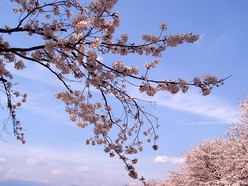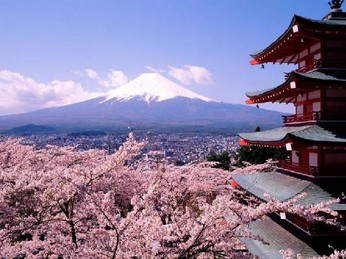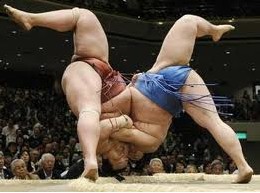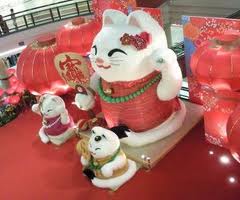提起日本之景,你一定会想到雄伟壮丽的富士山映衬着绚烂夺目的樱花;提起日本之艺,你当然不会忘记艺伎优美动人的舞姿与歌声;提起日本之技,映入你脑海的必是相扑选手别样激烈的竞技比赛;提起日本之物,你可还记得静坐于商店门口迎宾接客的招财猫?没错,正是这些别具特色的文化符号,演绎出了独一无二的日本风情。
With economic, cultural and religious influences from neighboring Asian states, Japan has produced a unique culture of its own. Now let’s enjoy the charm of Japanese culture and look at some of its popular icons.
日本在经济、文化以及宗教方面都受到其亚洲邻国的影响,并在此基础上产生了自己独具特色的文化。现在,就让我们来领略一下日本文化的魅力,看看有哪些流行的日本文化符号。
Sakura 樱花  In Japanese, the cherry is called “Sakura”, which is generally believed to be a corruption1) of the word “Sakuya” (blooming) from the name of Princess Kono-Hana-Sakuya-Hime. This long name means “tree-flowers-blooming princess”, for the cherry was so well-known in those early days in Japan that the flower meant nothing but cherry. The princess was so named because, it is said, she fell from heaven upon a cherry tree.
In Japanese, the cherry is called “Sakura”, which is generally believed to be a corruption1) of the word “Sakuya” (blooming) from the name of Princess Kono-Hana-Sakuya-Hime. This long name means “tree-flowers-blooming princess”, for the cherry was so well-known in those early days in Japan that the flower meant nothing but cherry. The princess was so named because, it is said, she fell from heaven upon a cherry tree.
The cherry blossom is the flower of flowers to the Japanese people. It symbolizes their national character. This is because the life of a samurai2) of feudal times was proverbially3) compared to the short-lived cherry blossoms that last “no more than three days”, for a samurai was always ready to sacrifice his life for the sake of his master. Another saying is that “what the cherry is among flowers is the samurai among men”.
The Japanese are very proud of their Sakura. Of all flowers, the cherry blossoms appeal most to the aesthetic taste of the Japanese people. The Japanese people are never so jubilant4), cheerful, optimistic and youthful as they are at the time of “Sakura” blossom.
在日本,樱花叫做“Sakura”,一般认为它是“Sakuya”(开花)的变体,该词取自女神Kono-Hana-Sakuya-Hime的名字。这个冗长的名字意为 “满树繁花女神”。在古代日本,人人皆知樱花之名,以至于人们提到“花”时,就单指樱花而别无其他了。据说,这位女神是由天国降落于樱花树上的,于是因此而得名。
对于日本人来说,樱花是花中之花,它是日本民族性格的象征。这种说法的由来源于这样一个人尽皆知的比喻,那就是把封建时代的武士比做生命短暂的樱花,因为樱花开不过三日便香消玉殒,正如武士随时准备为主人献出自己的生命。还有一则谚语作如此诠释:“樱花为百花之冠,武士乃人中豪杰。”
日本人皆以其樱花为傲。在所有花中,樱花最能迎合日本人的审美品位。舍却樱花开放的时节,再没有什么能让日本人感到如此欢欣雀跃、兴高采烈、充满希望、朝气蓬勃的了。
富士山
 In mountainous Japan, most of the mountains are part of mountain ranges. Mt. Fuji, however, soars into the sky alone. Located almost in the center of the country, this well-proportioned cone-shaped mountain has been worshiped by the Japanese people since ancient times, and is a well-known symbol of Japan in other countries. The highest peak in Japan (3,776 meters), Mt. Fuji is a relatively young volcano. The mountain is said to have reached its present shape about 5,000 years ago, but even since then, it has repeatedly erupted, and the last gigantic eruption occurred in 1707. For almost 300 years since then, Mt. Fuji has been quiet and retained its rarely noble figure, but some experts say that it will surely awake again.
In mountainous Japan, most of the mountains are part of mountain ranges. Mt. Fuji, however, soars into the sky alone. Located almost in the center of the country, this well-proportioned cone-shaped mountain has been worshiped by the Japanese people since ancient times, and is a well-known symbol of Japan in other countries. The highest peak in Japan (3,776 meters), Mt. Fuji is a relatively young volcano. The mountain is said to have reached its present shape about 5,000 years ago, but even since then, it has repeatedly erupted, and the last gigantic eruption occurred in 1707. For almost 300 years since then, Mt. Fuji has been quiet and retained its rarely noble figure, but some experts say that it will surely awake again.
Mt. Fuji has different views, changing with the seasons and even as the time flows during a day. In winter, it is covered with pure white snow. In summer, its bluish torso5) wears a delicate crown of snow and stands in the mist. And at sunset, the bright red figure is awesome6). Views from different viewpoints give different impressions. From Suruga Bay7) on the south, you can take a close look at the soaring mountain on board an excursion8) boat. Around the Fuji Five Lakes9) area, there are many points from which you can see the whole of Mt. Fuji towering over a beautiful lake. Even from central Tokyo, the summit of Mt. Fuji can be seen on a clear day.
在多山的日本,大多数山峰都只是山脉的一部分,独有富士山高耸入云。富士山几乎位于日本的中心地带,这个比例近乎完美的锥形山峰自古就受到日本人民的膜拜。而在外国人眼中,富士山则是日本广为人知的象征。作为日本的最高峰(海拔3,776米),富士山是一座相对年轻的火山。据说富士山目前的形态形成于约五千年前,但即使是从那时候起,它就已开始频繁喷发,最近的一次大喷发发生在1707年。在随后的近三百年中,富士山一直处于平静状态,保持了其难得的雄伟壮丽的姿态。但一些专家称,富士山定会再次“觉醒”。
富士山会随着季节变化呈现出不同的景色,甚至在一天当中,它的景致也会随着时间的推移而变幻。冬季,纯白的雪将它覆盖;夏季,黛青色的山体顶着精美的雪冠于云雾中挺立。而在夕阳西下时,渲染在山体上的鲜亮的红色更使它的景致美不胜收。从不同的角度观看富士山,你会收获不一样的景观。在其南侧的骏河湾,你可以乘坐游览船近距离观赏它高耸的山峰。在富士五湖周边地带,你可以从很多地方欣赏到整座富士山赫然屹立于美丽湖泊之上的景象。天气晴朗的时候,你甚至能在东京的市中心看到富士山的山顶。
Sumo相扑
 The word Geisha is derived from “Gei”, which in Japanese means performance or entertainer, and “sha”, which means “person”, and dates back 400 years ago to the Edo period10). During this period the Geisha entertained at banquets and social gatherings by playing Shamisen11), singing, and giving dance performances.
The word Geisha is derived from “Gei”, which in Japanese means performance or entertainer, and “sha”, which means “person”, and dates back 400 years ago to the Edo period10). During this period the Geisha entertained at banquets and social gatherings by playing Shamisen11), singing, and giving dance performances.
There is often a misconception by some that Geisha are prostitutes12), but nothing could be further from the truth. Geisha are refined and cultured girls and women who are highly trained in a variety of traditional skills. Besides playing Shamisen, singing, and dancing, the Geisha perform the Japanese tea ceremony, and are well versed13) in the art of conversation. Many learn to speak English in order to entertain Western guests.
The training involved in becoming a Geisha is very rigorous14), and because of this the numbers of Geisha are declining. To become a Geisha, if accepted, a young girl must go through an apprenticeship15) that involves living with a head Geisha. This training period takes five to six years. During this period of time, the Geisha trainee must help with the chores and the running of the house, learn customs and social skills, and take music and dance lessons. After about six months, the trainee Geisha is called a maiko16) girl, and accompanies a Geisha on her appointments in order to become acquainted with customers. At about age 20, the maiko must make the decision to become a full-fledged17) Geisha or not. If a girl wishes to marry she cannot become a Geisha.
Today in Japanese hotels and restaurants Geisha still entertain at banquets and socialize with guests, and the role of the Geisha in Japanese society is always a source of curiosity for tourists.
“艺伎”(Geisha)一词源于“Gei”和“sha”。前者在日语中意为“表演”或“艺人”,后者则为“人”的意思。“艺伎”一词可追溯到四百多年前的江户时代。那时,艺伎出入于各种宴会和社交聚会,以弹奏三弦琴、唱歌、跳舞来为客人助兴。
经常有人误认为艺伎就是妓女,但实际上这种想法简直是谬误至极。艺伎是优雅而有修养的女孩或者女人,她们在许多传统技艺上都受过良好的训练。除了弹奏三弦琴、唱歌及跳舞之外,艺伎还会表演日本茶道,并精于谈话的艺术。许多艺伎都会为了给西方客人表演而学习说英语。
成为一名艺伎需要接受非常严苛的训练,也正是因为如此,艺伎的人数正在不断减少。年轻的女孩想要成为一名艺伎,一旦被接受,就必须先经历一段学徒期,这期间她要与一名当家艺伎住在一起。这段受训时间为期五到六年,在此期间,艺伎学徒必须帮忙料理杂事和操持家务,学习风俗习惯和社交技巧,还要参加唱歌和舞蹈的课程。大概过六个月之后,学徒就被称做“舞伎”,这时她的任务就是陪同艺伎赴约,以便熟识主顾。到了二十岁左右,舞伎就要作出决定了:要么学成出师成为一名艺伎,要么就放弃。一个女孩想要结婚的话是不能成为艺伎的。
直到今天,在日本的旅店和餐馆中,艺伎依然在为宴席助兴,与客人交际。而艺伎在日本社会中扮演的角色一直以来都让他国的游客好奇不已。
Maneki Neko 招财猫
 Sumo is a Japanese style of wrestling and Japan’s national sport. It originated in ancient times as a performance to entertain the Shinto18) gods. Many rituals with religious background are still followed today.
Sumo is a Japanese style of wrestling and Japan’s national sport. It originated in ancient times as a performance to entertain the Shinto18) gods. Many rituals with religious background are still followed today.
The basic rules of sumo are simple: the wrestler who first touches the ground with anything besides the soles of his feet, or who leaves the ring before his opponent, loses. Fights take place on an elevated19) ring, called a “dohyo”, which is made of clay and covered in a layer of sand. The fights themselves usually last only a few seconds, or in rare cases, about a minute.
However, sumo is more than just a sport like football or basketball. There are many rituals and even religious elements involved in the content of the two wrestlers. Many of these rituals are connected to Shinto. A professional sumo wrestler, or rikishi, has many different rules and regulations to follow. These rules were created by the Sumo Association and regulate everything from meals to clothing to where they can live.
One interesting note is that, unlike wrestling and some other competitive sports, there are no weight classes in sumo. This means that a wrestler can end up competing against someone double his size in some cases.
相扑是一种日式的摔跤,也是日本的国技。它起源于古代为神道教诸神所进行的一种表演。其中的许多仪式都有着宗教背景,并沿用至今。
相扑的基本规则非常简单:只要选手脚底以外的其他任何身体部位先着地,或者比对手先一步离开比赛的环形场地,就算输了。比赛在高于地面的环形台上进行,该场地被称做“土俵”,由黄土堆砌而成,上面覆盖着一层沙子。比赛通常持续不过几秒钟,偶尔也有持续大概一分钟的罕见情形。
然而,相扑不像足球和篮球那样,仅仅是一项运动。两名摔跤手之间的竞技包含诸多仪式,甚至牵涉到很多宗教元素。其中许多仪式都同神道教有关。一名职业摔跤手,或者叫相扑手,需要遵守很多不同的规则。这些规则都由相扑协会制定,规定了包括饮食、衣着以及住所等在内的所有事宜。
有趣的是,不像摔跤或是一些其他竞技运动,相扑不分重量级。这就意味着在某些情况下,一名相扑手最后可能要同一个两倍于自己个头的人比赛。
1. corruption [kE5rQpFEn] n. (词语的)讹用;不标准;不纯;有讹误的东西
2. samurai [5sAmjJraI] n. (封建时代的)日本武士
3. proverbially [prE5vE:bIElI] adv. 如谚语所说地,众所周知地
4. jubilant [5dVu:bIlEnt] adj. 欢腾的,欢欣的,喜气洋洋的
5. torso [5tC:sEu] n. (人体的)躯干
6. awesome [5C:sEm] adj. 令人惊叹的
7. Suruga Bay:骏河湾(太平洋的一个小湾,位于日本本州岛东南,东京西南)
8. excursion [Ik5skE:FEn] n. 远足,游览
9. Fuji Five Lakes:富士五湖,是位于富士山靠山梨县一侧山麓的五个湖泊的总称。这五个湖泊是由于富士山火山喷发而形成的堰塞湖,包括河口湖、山中湖、西湖、本栖湖和精进湖。
10. Edo period:日本江户时代(1603~1867),德川幕府统治日本的年代,是日本封建统治的最后一个时代。
11. Shamisen:(日本的)三弦琴
12. prostitute [5prCstItju:t] n. 妓女,娼妓
13. versed [vE:st] adj. 精通的
14. rigorous [5rI^ErEs] adj. 严格的,严厉的
15. apprenticeship [E5prentIsFIp] n. 学徒的身份,学徒的年限
16. maiko [5maIkEu] n. [日] (经过培训的)舞伎
17. fledged [fledVd] adj. 成熟的;独立的
18. Shinto [5FIntEu] n. 日本的神道教,1945年前为日本国教。
19. elevated [5elIveItId] adj. 提高的
20. congenial [kEn5dVi:njEl] adj. 好交际的,和蔼的
21. incarnation [7InkB:5neIFEn] n. (象征某种品质、概念或思想等的)化身
